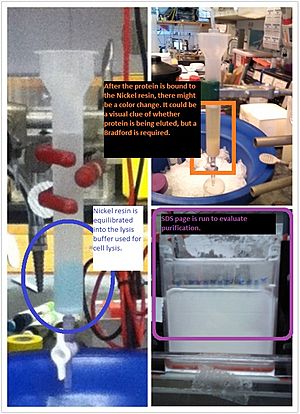Affinity chromatography facts for kids
Affinity chromatography is a clever way scientists separate different molecules from each other. Imagine you have a big mix of tiny building blocks, and you only want to pick out one specific type. Affinity chromatography helps scientists do just that! It's especially useful for molecules that come from living things, like proteins or DNA. It's a type of liquid separation method called chromatography.
This method works because molecules from living things often "stick" to some other molecules but not to others. Think of it like magnets: some magnets stick together, but they don't stick to wood or plastic. For example, a specific antibody (a tiny defender molecule in your body) will stick to its matching antigen (a harmful molecule it's supposed to fight), but not to a different antigen. In affinity chromatography, the molecule that your target molecule sticks to is called the ligand.
Contents
How Scientists Use Affinity Chromatography
To start, scientists first decide which molecule they want to separate. Then, they find its special "sticky partner," or ligand. This ligand could be an antibody, a piece of DNA, or another type of molecule that naturally binds to the target.
Preparing the "Sticky" Surface
Next, scientists prepare a special surface called the stationary phase. This can be made of tiny beads or membranes with small holes. They treat this stationary phase with the ligand, making sure the ligand is firmly attached. So now, you have a surface covered with the "sticky partners" for your target molecule.
Separating the Molecules
After preparing the stationary phase, scientists pour the mixture of molecules they want to separate over it. This mixture is called the mobile phase. Sometimes, they add a special liquid called a binding buffer. This buffer helps the target molecule stick tightly to its ligand on the stationary phase.
Then, scientists rinse away all the other unwanted molecules from the mixture. Because the target molecule is stuck to its ligand, which is stuck to the stationary phase, it doesn't get washed away. It stays put!
Collecting the Target Molecule
Finally, scientists add another special liquid called an elution buffer. This buffer makes the ligand "let go" of the target molecule. Once released, the target molecule can be collected separately. Scientists often use special machines to help them do all these steps precisely.
Why Molecules Stick and Unstick
Sometimes, the binding and elution buffers work by changing the pH of the liquid. pH tells us how acidic or non-acidic something is. Many molecules from living things change their shape depending on the pH around them. By changing the pH, the buffers can make the ligand and target molecule either hold on tighter or release each other.
When Affinity Chromatography Works Best
Affinity chromatography is a powerful tool, but it's not always perfect. Sometimes, scientists need to do more cleaning steps to make sure they only collected the target molecule and nothing else.
Because scientists need to know exactly which ligand will stick to their target molecule, they usually use affinity chromatography to collect molecules they already know a lot about. It's not often used to find completely new or unknown molecules.
Images for kids
See also
 In Spanish: Cromatografía de inmunoafinidad para niños
In Spanish: Cromatografía de inmunoafinidad para niños




